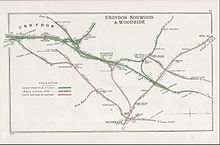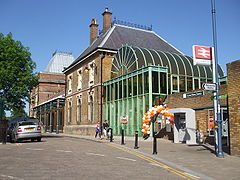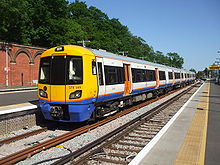- Crystal Palace railway station
-
This article is about the open Low Level station. For the disused High Level station, see Crystal Palace (High Level) railway station.
Crystal Palace 

Main station building
Location of Crystal Palace in Greater LondonLocation Crystal Palace Local authority London Borough of Bromley Managed by London Overground Owner Network Rail Station code CYP Number of platforms 6 Accessible 
Fare zone 3 and 4 National Rail annual entry and exit 2004-05  0.905 million[1]
0.905 million[1]2005-06  1.038 million[1]
1.038 million[1]2006-07  1.467 million[1]
1.467 million[1]2007-08  1.580 million[1]
1.580 million[1]2008-09  1.627 million[1]
1.627 million[1]10 June 1854 Opened (Crystal Palace) 1856 Through station 1 November 1898 Renamed (Crystal Palace Low Level) 13 June 1955 Renamed (Crystal Palace) List of stations Underground · National Rail External links Departures • Layout Facilities • Buses Coordinates: 51°25′06″N 0°04′21″W / 51.4182°N 0.0726°W
Crystal Palace railway station is in the London Borough of Bromley in south London. It is located in the Anerley area between the town centres of Crystal Palace and Penge. It is one of two stations built to serve the site of the 1851 exhibition building, the Crystal Palace, when it was moved from Hyde Park to Sydenham Hill after 1851.
The station was opened on 10 June 1854 by the West End of London and Crystal Palace Railway (WEL&CPR) to take the crowds to the relocated Palace. It was formerly known as Crystal Palace (Low Level) to differentiate it from the nearby and now demolished Crystal Palace (High Level) railway station.
The station became a terminus of the new East London Line section of the London Overground on 23 May 2010. This has been the catalyst for plans for a substantial redevelopment of the station.
Contents
History
 A 1908 Railway Clearing House map of lines around the Crystal Palace railway station, as well as surrounding lines
A 1908 Railway Clearing House map of lines around the Crystal Palace railway station, as well as surrounding lines
From the outset trains were operated by the London, Brighton and South Coast Railway (LBSCR). Initially the station was the terminus of a spur line from Sydenham. In 1856 the station was able to take through train services to Clapham Junction via West Norwood and Streatham Hill, following the completion of the 746 yard (690 m) Crystal Palace Tunnel. Although relatively short, the tunnel was regarded as a major engineering achievement as it was cut "through the same treacherous material [clay], through the hill on which the Crystal Palace stands, and immediately under one of the great water towers, a superincumbent weight of 2,200 tons which taxed in its execution all the skill and workmanship of the eminent contractors."[2]
In 1857, an eastward connection was made to Norwood Junction (for the Brighton line to the south) and in 1858 the WEL&CPR was extended as far as Beckenham. From 1860 direct services were available from London Victoria.
The frontage of the station was rebuilt in 1875, and was described: "Although the Roman Catholic chapel room is no longer used the station still has a cathedral-like atmosphere as one passes from the period booking hall to the vault-like station and the stairs down to the original station area".[3]
This is a description of the station trainshed roof above the staircases at the west end. However, the rest of the station has no shelter from the elements between the vast brick retaining walls. Originally the whole length of the platforms beyond the bottom of the massive staircases was covered by an elegant dual bow-spring arch iron roof. This was removed as a precautionary measure shortly after the collapse of the similar structure at Charing Cross in 1905.
The line was electrified between Balham and Crystal Palace on 12 May 1911, using the LBSCR overhead system, in time for the Festival of Empire coinciding with the coronation of King George V. Electric trains from Victoria were advertised to complete the journey in fifteen minutes - a running time that has never been equalled.
The station is built on the junction of two lines: the original station platforms lying on the Sydenham route, and the later platforms on the southern spur to Norwood Junction and Beckenham Junction.
Following the fire in 1936 which destroyed the Crystal Palace passenger numbers fell and most services through the station were diverted to serve London-Croydon routes rather than running along the Outer South London Line. The southern platforms became the busier pair and the entrance to the station was moved to the south side of the building in the 1980s. The glazed ticket hall, which echoes the profile of the Crystal Palace with its arched roof structure, was constructed at this time.
The original station was partially refurbished in 2002 by Railtrack at a cost of £4 million. This included a substantial amount of work on the roof of the building and refurbishment of office space on the top floor.
The two outer bay platforms, which were used by terminating trains, were abandoned in the 1970s and the third rail was removed, although the track and buffers were left in place. The southern bay was brought back into use in May 2010 as part of the East London Line development.
Transport for London were also proposing to extend Tramlink from Harrington Road through Anerley to the bus station on Crystal Palace Parade, with three possible routes.[4] However, Mayor Boris Johnson cancelled the £170 million project in November 2008.[5]
Transport links
London Buses route 157, 249, 358, 410, 432 and night route N3.
Services
Regular train services which serve Crystal Palace today comprise four different routes:
- 2tph (trains per hour) between London Victoria and West Croydon
- 2tph between London Victoria and London Bridge (the outer South London Line service)
- 2tph between London Bridge and Beckenham Junction
- 4tph between this station and Highbury & Islington, via New Cross Gate and Whitechapel
Alternative routes run at peak hours, and the middle two do not run during late evenings, when route 1 listed above is also extended to Epsom and Epsom Downs. On Sunday route 1 is also extended to Sutton.
The London Overground services to Highbury & Islington also run in the late evenings and on holidays.
Preceding station  National Rail
National RailFollowing station Gipsy Hill Southern
South London Line (Outer)Sydenham Southern
London Bridge to Beckenham Junction
(via Crystal Palace)
(Monday-Saturday)Birkbeck Southern
London Victoria to Sutton via Crystal PalaceNorwood Junction Terminus London Overground
East London LineSydenham Station redevelopment
To accommodate the additional East London Line services, and to provide disabled access to all platforms of the station, substantial works are required at the station. A planning application was submitted to Bromley Council in February 2009, which will include alterations to the Victorian booking hall building, removal of the current ticket office, removal of the pedestrian bridge over Platforms 1 and 2 and new stairs to Platform 1. The original entrance and ticket hall will be brought back into use, with three lifts installed to provide access to the platforms and a new canopy will be installed over platforms 3-7.[6]
London Overground trains now terminate in either the southern (formerly disused) bay platform 3, or a new bay platform 5, part of the new central platform which has been built over the site of the removed sidings, in the centre of the old station. The two through lines serve platform 4 (previously platform 3) and platform 6, the north side face of the new central island. The former platform 4 is no longer in public use, and while at the time of the East London Line service commencing it still had its platform furniture and information displays, these have since been removed.
References
- ^ a b c d e "Station usage". Rail statistics. Office of Rail Regulation. 30 April 2010. http://www.rail-reg.gov.uk/server/show/nav.1529. Retrieved 17 January 2011. Please note: Some methodology may vary year on year.
- ^ Illustrated London News, 1 November 1856
- ^ Railways of the Southern Region (PSL Field Guide, Geoffrey Body, 1984))
- ^ Transport for London - Croydon Tramlink Consultation
- ^ [1] BBC News TfL scraps projects
- ^ [2] Crystal Palace station redevelopment planning application to Bromley council
External links
- Opening Ceremony for Refurbished Offices 19 July 2002, The Railway Consultancy Ltd
- Train times and station information for Crystal Palace railway station from National Rail
London Overground Current routes Anerley · Brockley
· Brockley  · Canada Water
· Canada Water  · Canonbury · Crystal Palace
· Canonbury · Crystal Palace  · Dalston Junction · Forest Hill
· Dalston Junction · Forest Hill  · Haggerston · Highbury & Islington
· Haggerston · Highbury & Islington 
 · Honor Oak Park
· Honor Oak Park  · Hoxton · New Cross
· Hoxton · New Cross  · New Cross Gate
· New Cross Gate  · Norwood Junction
· Norwood Junction  · Penge West
· Penge West  · Rotherhithe · Shadwell
· Rotherhithe · Shadwell  · Shoreditch High Street · Surrey Quays · Sydenham
· Shoreditch High Street · Surrey Quays · Sydenham  · Wapping · West Croydon
· Wapping · West Croydon 
 ·
·
Whitechapel Acton Central · Brondesbury · Brondesbury Park · Caledonian Road & Barnsbury · Camden Road · Canonbury · Dalston Kingsland · Finchley Road & Frognal · Gospel Oak · Gunnersbury
Acton Central · Brondesbury · Brondesbury Park · Caledonian Road & Barnsbury · Camden Road · Canonbury · Dalston Kingsland · Finchley Road & Frognal · Gospel Oak · Gunnersbury · Hackney Central · Hackney Wick · Hampstead Heath · Highbury & Islington
· Hackney Central · Hackney Wick · Hampstead Heath · Highbury & Islington 
 · Homerton · Kensal Rise · Kentish Town West · Kew Gardens
· Homerton · Kensal Rise · Kentish Town West · Kew Gardens  · Richmond
· Richmond 
 · South Acton ·
· South Acton ·
Stratford

 · West Hampstead
· West Hampstead 
 · Willesden Junction
· Willesden Junction  Bushey
Bushey · Carpenders Park · London Euston
· Carpenders Park · London Euston 
 · Harlesden
· Harlesden  · Harrow & Wealdstone
· Harrow & Wealdstone 
 · Hatch End · Headstone Lane · Kensal Green
· Hatch End · Headstone Lane · Kensal Green  · Kenton
· Kenton  · Kilburn High Road · North Wembley
· Kilburn High Road · North Wembley  · Queen's Park
· Queen's Park  · South Hampstead · South Kenton
· South Hampstead · South Kenton  · Stonebridge Park
· Stonebridge Park  · Watford High Street · Watford Junction
· Watford High Street · Watford Junction  · Wembley Central
· Wembley Central 
 · Willesden Junction
· Willesden Junction  Clapham Junction
Clapham Junction · Imperial Wharf
· Imperial Wharf  · Kensington (Olympia)
· Kensington (Olympia) 
 · Shepherd's Bush
· Shepherd's Bush 
 · West Brompton
· West Brompton 
 · Willesden Junction
· Willesden Junction 
Future phases South London LineProposed stationsRolling stock Former rolling stock Operations History Tramlink 
Tramlink route 1 Addiscombe • Arena • Blackhorse Lane • Centrale • Church Street • East Croydon • Elmers End
• Elmers End  • George Street • Lebanon Road • Sandilands • Wellesley Road • West Croydon
• George Street • Lebanon Road • Sandilands • Wellesley Road • West Croydon  • Woodside
• Woodside
Tramlink route 2 Tramlink route 3 Addington Village • Ampere Way • Beddington Lane • Belgrave Walk • Centrale • Church Street • Coombe Lane • Dundonald Road • East Croydon • Fieldway • George Street • Gravel Hill • King Henry's Drive • Lebanon Road • Lloyd Park • Merton Park • Mitcham Junction • Mitcham • Morden Road • New Addington • Phipps Bridge • Reeves Corner • Sandilands • Therapia Lane • Waddon Marsh • Wandle Park • Wellesley Road • West Croydon
• Fieldway • George Street • Gravel Hill • King Henry's Drive • Lebanon Road • Lloyd Park • Merton Park • Mitcham Junction • Mitcham • Morden Road • New Addington • Phipps Bridge • Reeves Corner • Sandilands • Therapia Lane • Waddon Marsh • Wandle Park • Wellesley Road • West Croydon  • Wimbledon
• Wimbledon 

Tramlink route 4
(Proposed)Addiscombe • Anerley Road • Arena • Avenue Road • Beckenham Junction • Beckenham Road • Birbeck
• Beckenham Road • Birbeck  • Blackhorse Lane • Centrale • Church Street • Crystal Palace
• Blackhorse Lane • Centrale • Church Street • Crystal Palace  • Crystal Palace Parade • East Croydon
• Crystal Palace Parade • East Croydon  • George Street • Harrington Road • Lebanon Road • Penge Road • Sandilands • Wellesley Road • West Croydon
• George Street • Harrington Road • Lebanon Road • Penge Road • Sandilands • Wellesley Road • West Croydon  • Woodside
• WoodsideFuture Tramlink Stations Anerley Road • Crystal Palace Parade • Penge Road Map of proposed extensionFuture Proposals Since 2008, TfL proposals for an extension to Tramlink route 4 have been put on hold until after Crossrail Line 1 in 2018.Rolling Stock CR4000 (New Livery in 2009)Tramlink Network Map Categories:- Rail transport stations in London fare zone 3
- Rail transport stations in London fare zone 4
- Railway stations in Bromley
- Former London, Brighton and South Coast Railway stations
- Railway stations opened in 1854
- Railway stations served by London Overground
- Railway stations served by Southern
- DfT Category D stations
- Glass architecture
Wikimedia Foundation. 2010.




